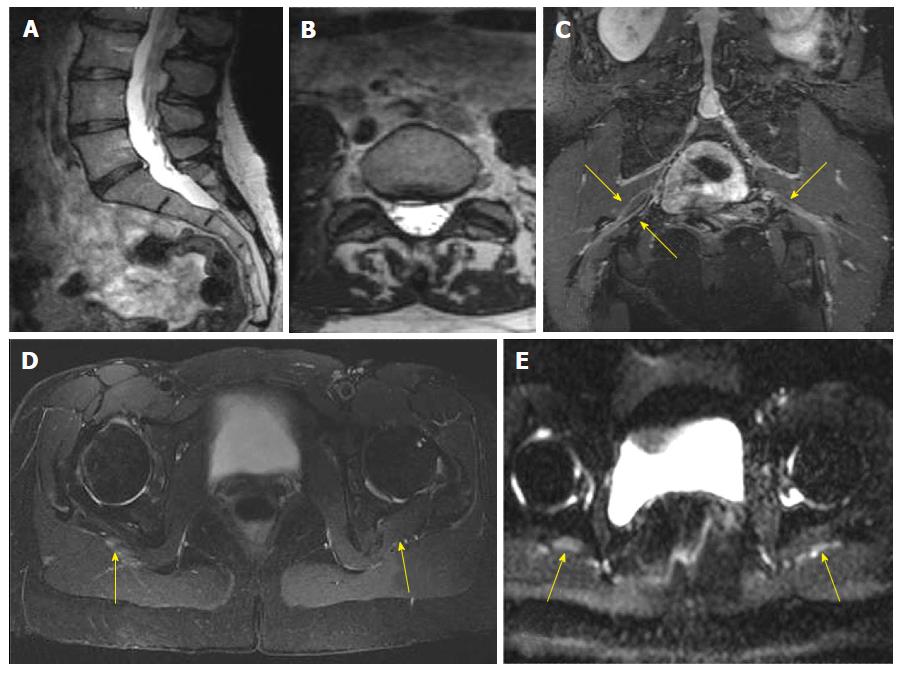Copyright
©The Author(s) 2016.
World J Radiol. Jan 28, 2016; 8(1): 109-116
Published online Jan 28, 2016. doi: 10.4329/wjr.v8.i1.109
Published online Jan 28, 2016. doi: 10.4329/wjr.v8.i1.109
Figure 1 Right femoral neuropathy.
A 22-year-old man with prior motor vehicle accident and right iliac bone surgery presented with severe right anterior leg pain and partial limb weakness, ongoing for more than 1 yr. Outside MR imaging of LS spine was normal and EMG was negative. Outside right hip MRI was also reported normal. Sagittal LS spine T2 TSE (A) as part of the plexus protocol shows normal imaging appearance. Axial T1W (B) image shows irregular fibrosis along the expected course of the right femoral nerve with ipsilateral iliopsoas atrophy (arrow). Axial MIP reconstructed 3D IR TSE (C) image shows focal loss of signal along the right femoral nerve due to fibrous entrapment (arrows). Axial T2 SPAIR (D) and DTI tensor images (E) show the abnormal signal size alteration of the right femoral nerve (arrows). Axial T1W image of the lower pelvis (F) shows right quadriceps atrophy (arrow). Right Femoral Nerve- Mean FA = 0.45 Mean ADC = 1320 mm2/s; Left Femoral Nerve- Mean FA = 0.77 Mean ADC = 1136.8 mm2/s. MR: Magnetic resonance; LS: Lumbosacral; EMG: Electromyogram; TSE: Turbo spin echo; MRI: Magnetic resonance imaging; T: Tesla; MIP: Maximum intensity projection; 3D: 3-Dimensional; IR: Inversion recovery; SPAIR: Spectral adiabatic inversion recovery; DTI: Diffusion tensor imaging; FA: Fractional anisotropy; ADC: Apparent diffusion coeffcient.
Figure 2 Right piriformis syndrome.
A 42-year-old woman with 2 yr history of intermittent partial foot drops and right gluteal pain. EMG was negative. Outside MR imaging of LS spine was reported normal, except small disc herniation at L5-S1 level. MRN LS plexus (A-E) shows small annular fissure and right paracentral disc herniation at L5-S1 level (A, B) on 3D TSE imaging of lumbar spine. Coronal 3D IR TSE (C) shows bilateral split sciatic nerves (right > left, arrows). Axial T2 SPAIR (D) image shows mildly enlarged and hyperintense right sciatic nerve (arrows), immediately outside the greater sciatic notch. Axial DTI (E) confirms more conspicuity of the right sciatic nerve abnormality (arrows). MR: Magnetic resonance; LS: Lumbosacral; MRN: Magnetic resonance neurography; IR: Inversion recovery; 3D: 3-Dimensional; DTI: Diffusion tensor imaging; SPAIR: Spectral adiabatic inversion recovery; EMG: Electromyogram; TSE: Turbo spin echo..
Figure 3 Left sciatic chronic neuropathy.
A 65-year-old man with prior left pelvic bone fracture and persistent left radicular pain. EMG was negative. MR imaging of LS spine obtained 12 mo (A) and 6 mo (B) before the MRN LS plexus examination (C-F) shows multilevel mild degenerative changes. Axial T1W (D), corresponding T2 SPAIR (E), 3D IR TSE (F) and axial DTI tensor (G) images show asymmetric mild increased signal of the left sciatic nerve with mild fatty infiltration (arrows). MR: Magnetic resonance; LS: Lumbosacral; T: Tesla; MRN: Magnetic resonance neurography; IR: Inversion recovery; 3D: 3-Dimensional; DTI: Diffusion tensor imaging; SPAIR: Spectral adiabatic inversion recovery; EMG: Electromyogram.
Figure 4 Right Lumbosacral plexopathy.
A 74-year-old woman with right leg and pelvic pain and mild right leg weakness. Outside LS spine MR (A and B) was reported negative. MRN LS plexus shows the transitional, partially sacralized L5 vertebra (C and D) and abnormally hyperintense right sided nerves (E), namely, lateral femoral cutaneous nerve (small arrow); femoral nerve (medium arrow), and L5 nerve (large arrow). Axial T2 SPAIR image shows hyperintense iliohypogastric nerve (arrow in F) and 3D MIP IR TSE image (G) confirms the right sided neural abnormalities. Axial DTI (H and I) images show the conspicuous abnormality of the right femoral (arrow in H) and sciatic (arrow in I) nerves. Right L4 Nerve- Mean FA = 0.46 Mean ADC = 1231 mm2/s; Left L4 Nerve- Mean FA = 0.5 Mean ADC = 1304. Right L5 Nerve-Mean FA = 0.26 Mean ADC = 1193.7 mm2/s; Left L5 Nerve-Mean FA = 0.36 Mean ADC = 1141 mm2/s. MR: Magnetic resonance; MRN: Magnetic resonance neurography; LS: Lumbosacral; MRI: Magnetic resonance imaging; T: Tesla; 3D: 3-Dimensional; IR: Inversion recovery; SPAIR: Spectral adiabatic inversion recovery; DTI: Diffusion tensor imaging; FA: Fractional anisotropy; ADC: Apparent diffusion coeffcient; TSE: Turbo spin echo.
- Citation: Chhabra A, Farahani SJ, Thawait GK, Wadhwa V, Belzberg AJ, Carrino JA. Incremental value of magnetic resonance neurography of Lumbosacral plexus over non-contributory lumbar spine magnetic resonance imaging in radiculopathy: A prospective study. World J Radiol 2016; 8(1): 109-116
- URL: https://www.wjgnet.com/1949-8470/full/v8/i1/109.htm
- DOI: https://dx.doi.org/10.4329/wjr.v8.i1.109












